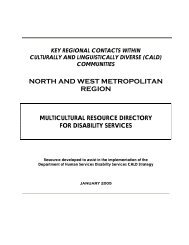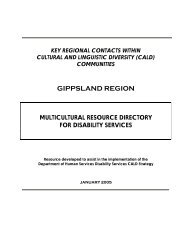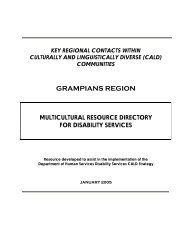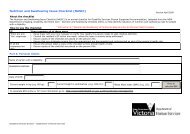Positive Behaviour Support - Department of Human Services - Vic ...
Positive Behaviour Support - Department of Human Services - Vic ...
Positive Behaviour Support - Department of Human Services - Vic ...
Create successful ePaper yourself
Turn your PDF publications into a flip-book with our unique Google optimized e-Paper software.
80 <strong>Positive</strong> behaviour support: Getting it right from the start - Facilitators reference manual<br />
PowerPoint 108<br />
PowerPoint 109<br />
*<br />
*<br />
The steps involved in setting up an incentive program<br />
1. Select the target behaviour.<br />
2. Select the time interval without displaying the target behaviour (half the average time between<br />
incidents).<br />
3. Select the incentives. These should be:<br />
• ordinary<br />
• age appropriate<br />
• added to the person’s life<br />
• available non-conditionally after the program.<br />
You should ensure that the maximum number <strong>of</strong> rewards available is less than the person<br />
would seek given free access to it. The best way to do this is to construct an incentive menu.<br />
4. Develop a system for monitoring the person’s performance (for example, signature chart).<br />
5. Provide positive feedback paired with access to an incentive when the person goes for a whole<br />
interval without displaying the target behaviour.<br />
6. When a target behaviour occurs, simply leave the space on the chart blank. Do not criticise the<br />
person, but simply encourage them to try to go for the next interval without displaying the target<br />
behaviour.<br />
7. As the person’s behaviour improves, extend the amount <strong>of</strong> time they need to go before earning<br />
a reward.<br />
8. When they have reached the program objective, make sure the person can still access the<br />
incentives on an informal basis. This will, in effect, enrich the person’s life and help to prevent<br />
behaviours from recurring.<br />
Situational control<br />
Situational control strategies are for behaviours that are OK as long as they occur at the<br />
right time and in the right place. They consist <strong>of</strong> teaching the person in what situations it is<br />
appropriate to engage in the behaviour, and in what situations it is not.<br />
Situational control can be used for behaviours like:<br />
• Complaining<br />
• Masturbation<br />
• Spitting<br />
• Nose picking<br />
• Dressing up in clothing <strong>of</strong> the opposite sex.<br />
The following situational control was set up to deal with Andrea’s excessive complaining.<br />
Andrea<br />
Andrea was told that she could have the undivided attention <strong>of</strong> staff every evening for ten<br />
minutes where she could complain about the things that went wrong for her that day.












